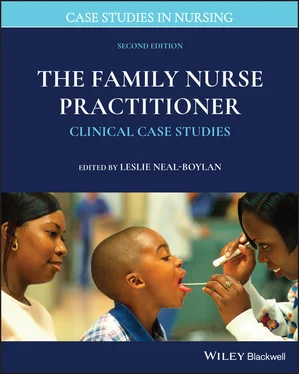Nose:Both nostrils are patent; no discharge.
Oropharynx:Mucous membranes are moist; no teeth are present; no lesions.
Neck:Supple; no nodes.
Respiratory:RR = 24; clear in all lobes; no adventitious sounds noted; no retractions; no deformities of the thoracic cage noted.
Cardiac/Peripheral vascular:HR = 120; vibratory, systolic, grade 2 heart murmur noted on exam at the lower left sternal border area of the chest with both the bell and diaphragm; heard best in the supine position; no heaves or thrills noted; no radiation of the murmur to the back or axilla; brachial and femoral pulses present and 2+ bilaterally.
Abdomen/Gastrointestinal:Soft, nontender, nondistended, no evidence of hepatosplenomegaly.
Genitourinary:Normal circumcised male genitalia; testes descended bilaterally.
Back:Spine straight.
Ext:Full range of motion of all extremities; warm and well perfused; capillary refill < 2 seconds.
Neurologic:Good strength and tone.
1 Which diagnostic or imaging studies should be considered to assist with or confirm the diagnosis?___Chest radiograph___Echocardiogram___Electrocardiogram
2 What is the most likely differential diagnosis and why?___Patent ductus arteriosus (PDA)___Ventricular septal defect (VSD)___Still’s murmur
3 What is the plan of treatment, referral, and follow‐up care?
4 Are there any referrals needed?
5 Does the patient’s psychosocial history impact how you might treat him?
6 What if this baby were a girl?
7 What if this baby were 6 months old?
8 Are there any standardized guidelines that should used to assess or treat this case?
By Mikki Meadows‐Oliver, PhD, RN, FAAN
Katelynn, a 7‐month‐old infant, presents to the office with complaints of cough for 2 days and “breathing heavy” since this morning. Katelynn is accompanied by both parents. She has had a fever for 2 days. Her maximum temperature at home was 101°F (rectal). She also has a runny nose. Her mother has tried an over‐the‐counter cough medicine without much relief. Katelynn’s mother has not found much that helps the symptoms; but she notices that, when Katelynn cries, the breathing sounds get worse. Katelynn attends day care and her mother states that many of the kids there have coughs and runny noses. Katelynn’s mother also has had cold symptoms for nearly 5 days.
Birth history:Katelynn was the product of a 40‐week gestation. She was delivered vaginally without complications. During the pregnancy, Katelynn’s mother had no falls, infections, or known exposures to environmental hazards. She did not drink alcohol, take over‐the‐counter or prescription medication (other than prenatal vitamins), use tobacco products, or use illicit drugs. Katelynn’s birth weight was 3300 g and her Apgar scores were 9 at 1 minute and 9 at 5 minutes.
Social history:Katelynn was born to a 31‐year‐old mother. Katelynn has a 2‐year‐old sibling. She lives at home with both parents and her older sibling. Both parents have high school diplomas. The mother works as an administrative assistant, and the father works as a maintenance worker. There are no pets or smokers in the home.
Diet:Decreased solid and liquid intake since yesterday.
Elimination:Decreased urine output; no diarrhea or constipation.
Sleep:Sleep is interrupted by coughing.
Family medical history:Paternal grandfather (PGF) (age 60): history of prostate cancer; paternal grandmother (PGM) (age 59): healthy; maternal grandfather (MGF) (age 61): Type 2 diabetes mellitus, high cholesterol, high blood pressure; maternal grandmother (MGM) (age 61): asthma; mother (age 31): asthma; father (age 30): healthy; sibling (age 2): healthy; history of bronchiolitis.
Medications:Currently taking no prescription or herbal medications. Taking a children’s over‐the‐counter cough suppressant.
Immunizations:Up to date.
Allergies:No known allergies to food, medications, or environment.
Vital signs:Weight: 7.1 kg; length: 65 cm; temperature: 37.9°C (rectal); pulse oximeter reading: 95% on room air.
General:Alert, active, well‐hydrated, interactive baby.
Skin:Clear with no lesions noted; no cyanosis of skin, lips, or nails; no diaphoresis noted; good skin turgor.
Head:Normocephalic; anterior fontanel is open and flat (1.5 cm × 1.5 cm).
Eyes:Red reflexes present bilaterally; pupils equal, round, and reactive to light; no discharge noted.
Ears:Pinnae normal; tympanic membranes gray bilaterally with positive light reflex.
Nose:Both nostrils patent; no discharge; mild nasal flaring.
Oropharynx:Mucous membranes moist; no teeth present; no lesions.
Neck:Supple; no nodes.
Respiratory:RR = 32; barking cough noted; inspiratory stridor with activity; no intercostal, supra‐sternal, or subcostal retractions; no grunting; no deformities of the thoracic cage noted.
Cardiac/Peripheral vascular:HR = 120; regular rhythm; no murmur noted; brachial and femoral pulses present and 2+ bilaterally.
Abdomen/Gastrointestinal:Soft, nontender, nondistended, no evidence of hepatosplenomegaly.
Genitourinary:Normal female genitalia.
Back:Spine straight.
Extremities:Full range of motion of all extremities; warm and well perfused; capillary refill < 2 seconds.
Neurologic:Good tone in all extremities.
1 Which diagnostic or imaging studies should be considered to assist with or confirm the diagnosis?___Chest X‐ray (CXR)___Arterial blood gas (ABG)___Complete blood count (CBC)
2 What is the most likely differential diagnosis and why?___Croup (laryngotracheobronchitis)___Bronchiolitis___Epiglottitis
3 What is the plan of treatment, referral, and follow‐up care?
4 Are there any demographic characteristics that would affect this case?
5 What if the patient lived in a rural, isolated setting?
By Mikki Meadows‐Oliver, PhD, RN, FAAN
David, an 11‐month‐old infant, presents to the office with complaints of watery diarrhea for 1 day. David is accompanied by his mother. In addition to the diarrhea, he has had vomiting for 1 day and a fever for 2 days. His maximum temperature at home was 102°F (rectal). David has not vomited today, although the fever continues and the diarrhea seems to be getting worse. He has had at least 10 diapers with diarrhea since yesterday. David’s mother is unsure of his urine output because each diaper is so full of stool. No blood or mucus has been noted in the stool. His mother believes that a rash is starting on his buttocks due to the diarrhea. She knows that another child in the day care center had diarrhea a few days ago. No one at home has any similar symptoms.
Yesterday, David completed a course of amoxicillin for otitis media. David’s mother states that earlier in the week she began to introduce whole milk into his diet and that she also gave him Indian take‐out food with a strong curry flavor. She is concerned that one of these factors may have caused or contributed to David’s diarrhea. Further review of systems reveals that David has had decreased solid food and soy formula intake since yesterday and that he has been sleeping more than usual.
Читать дальше












